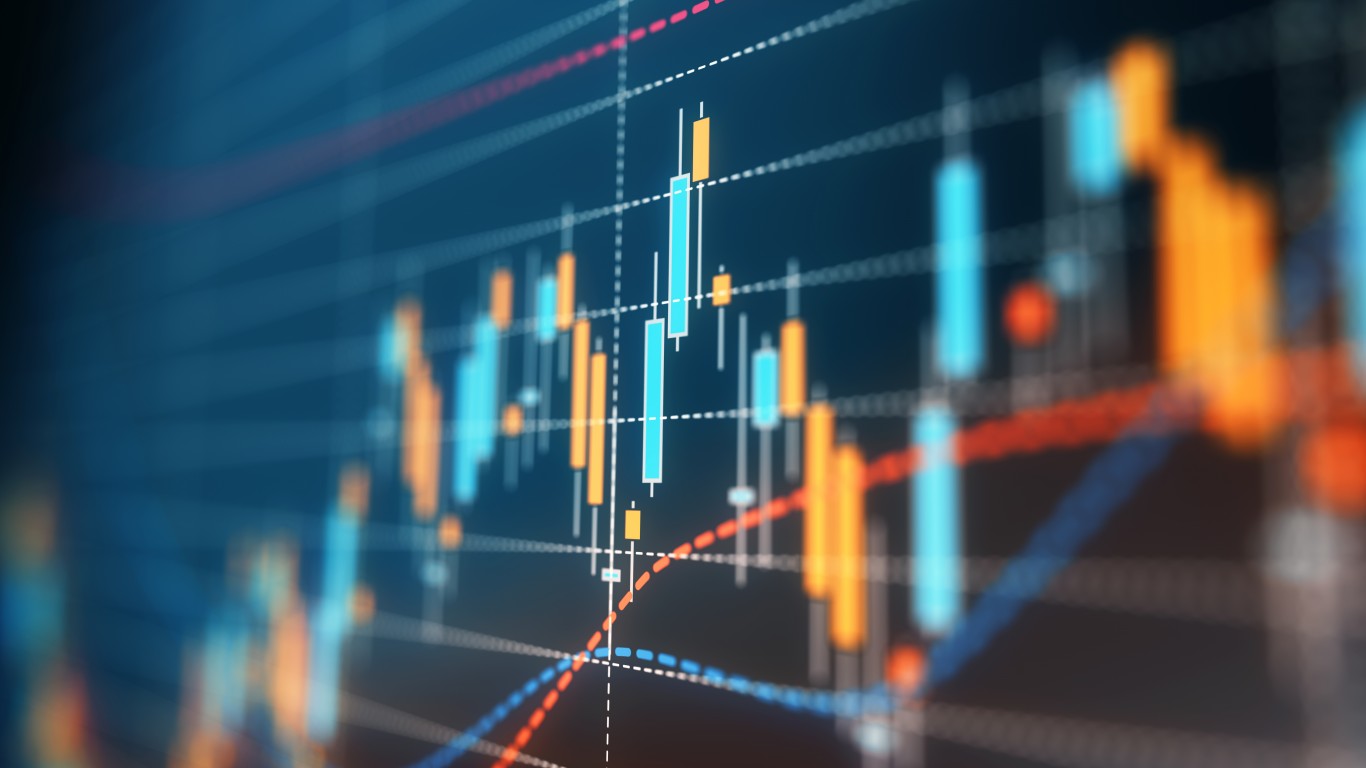This post may contain links from our sponsors and affiliates, and Flywheel Publishing may receive
compensation for actions taken through them.
Stocks are effectively at their all-time highs, and now we have the Federal Reserve promising again to not bring swift and massive interest rate hikes. This is a great climate for dividend stocks, and investors just love companies that keep raising their dividend payments. 24/7 Wall St. has already telegraphed several key dividend hikes that have come about in recent weeks, and now there are six more key dividend hikes that investors should be expecting within the next 30 to 45 days.
The so-called Dividend Aristocrats are companies in the S&P 500 Index that have raised their dividends for 25 years or more. Not all the six dividend hikes we expect ahead are in the Dividend Aristocrat category, but some are. Many exchange traded funds have arisen around the strategy of higher dividend payouts.
To project future dividends, investors have to consider earnings per share, growth rates of that income and a payout ratio to make sure they are not getting too far ahead of themselves. Another consideration is a cash limitation from debt covenants, or if that cash on the balance sheet is held overseas and inaccessible without the repatriation penalty.
Companies raising their dividends are effectively sending the message to investors that they have earnings visibility and cash flow visibility for years and years. Dividend hikes may also be a signal of confidence under corporate governance and capital allocations. We had accurately projected that the major banks would be allowed to increase their dividends, and even caught on to the notion that Bank of America might be hamstrung by the Fed.
ALSO READ: UBS Dividend Ruler Stocks Keep Raising Dividend Payouts
Before getting too brazen in dividend growth expectations, keep in mind that dividend hikes have become routine enough around the market and many investors just expect dividend hikes no matter what. Without growth, and under certain capital limitations, dividend hikes cannot continue forever. Just do not tell that to these next six companies expected to raise their dividends.
Of the next six dividend hikes expected, none are banks. 24/7 Wall St. expects two oil dividend hikes (yes, really in oil), two in technology, one in consumer products and perhaps even an airline dividend hike.
It is of course possible that not all these companies will raise their dividends. It happens. All caveats aside, these companies have either raised dividends for years, they have just embarked on better payouts or they are in need of a dividend hike. It seems more than a safe assumption that investors will not be happy at all if these companies do not raise their dividends.
One-Month Countdown to Apple’s Big Dividend Hike
Apple Inc. (NASDAQ: AAPL) is relatively new to the game of paying dividends and buying back stock, but the consumer electronics giant has so much cash that it has to boost its dividend payment and to keep buying back stock. Apple is still considered a cheap stock, but its dividend yield is a mere 1.5% — low for a company being added to the Dow Jones Industrial Average. Barron’s recently threw out a $160 Apple share price target, in part due to higher dividends and buybacks.
The iPhone 6 continues to be the growth driver today, as does growth in China. New initiatives from the Apple Watch and whatever TV or media plans are coming. Investors should expect an announcement of a dividend hike with the earnings report in mid-April. Our projection is that the dividend will be raised from $0.47 per share to around $0.60 per share. It could of course be even higher, as this level gets the yield to almost 1.9%. A $2.40 annualized payout would compare to the consensus estimate of $8.61 per share for 2015, a payout ratio of about 28%, not counting the buybacks.
Apple was recently trading at $128.50, in a 52-week range of $73.05 to $133.60. The stock has a consensus analyst price target of $138.90, but the highest analyst target price is up at $160.
ALSO READ: 9 Big Companies That Just Refuse to Pay Dividends
Chevron Will Deliver, but Maybe Just Barely
Chevron Corp. (NYSE: CVX) delivered a 7% dividend hike last April, months before knowing that oil was going to fall to under $50 a barrel. The company most recently kept its $1.07 per share dividend, and it seems as though it will only deliver a token dividend hike so that it can maintain its status as a dividend grower. Chevron also recently raised $6 billion in a debt offering to shore up its balance sheet.
Earnings were over $10 per share in 2014. The consensus earnings estimate is now $3.81 per share for 2015, down from over $9 per share about 100 days ago. Chevron’s annualized payout of $4.28 presents a conundrum with lower and lower earnings expectations, so we will only predict a 1% dividend hike here, rather than the 7% seen last year. The caveat is if oil drops even further, say, to under $40 per barrel. The current yield is now about 4.2% (high even for a DJIA stock), which does not exactly force it to be too aggressive in raising its payout.
Chevron said as recently as March 10: “Our intention is to demonstrate performance that will allow our 27-year history of successive increases in our annual dividend payout to continue.” Chevron shares were changing hands recently at $106.70. The consensus analyst price target is $113.88, and the 52-week trading range is $98.88 to $135.10.
Exxon Mobil May Show Better Dividend Growth Than Chevron
Exxon Mobil Corp. (NYSE: XOM) may be victim of the same oil price crash as Chevron and others, but Exxon may have more wiggle room than Chevron on how much of a token dividend hike it will announce. Exxon also wants to be able to say it has raised dividends endlessly. Exxon Mobil shareholders should still have conservative expectations about how much of the dividend will be hiked.
It seems safe to assume that Exxon will not duplicate the 9.5% payout hike seen in 2014. Its current yield is 3.2%, so it has a long way to go before catching up to rival Chevron. The company’s $2.76 annualized payout compares to $3.79 in earnings per share expected by analysts for 2015, although it did earn $7.36 per share in 2014.
Goldman Sachs recently started Exxon Mobil with a Buy rating, and we even showed that investors were trying to signal the potential start of the stock bottoming out. CEO Rex Tillerson said on March 4: “We remain committed to our investment discipline and maintaining a reliable and growing dividend.” If Exxon does not raise its dividend, then maybe Warren Buffett was right to panic sell his shares.
ALSO READ: 6 Dream Mergers That Ought to Happen
Exxon shares were priced recently at $86.26 on a 52-week trading range of $82.68 to $104.76. The stock has a 52-week trading range of $82.68 to $104.76.
Big Blue Can Grow Its Dividend, Even Without Earnings Growth
International Business Machines Corp. (NYSE: IBM) may have no growth and no great story to tell, but it can continue to talk up its earnings power, low valuation, massive share buybacks and history of raising dividends. IBM’s earnings per share growth has been financially engineered by cost cuts and endless share buybacks, but it has managed to raise its dividend payout 16% in 2014. Even after coming clean about not being able to hit the old $20 per share in earnings goal, IBM’s annualized dividend payout of $4.40 compares to a consensus earnings estimate of almost $16 per share for 2015. That is a 28% payout ratio, without considering serious share buybacks, and IBM already yields nearly 2.9%.
IBM has already raised its dividend for 19 consecutive years, and its 2014 dividend hike was its 11th year in a row of double-digit percentage hikes. If IBM wants to maintain the same double-digit hike trend, then the $1.10 per quarter dividend will have to go up to a minimum of $1.21. IBM’s annual shareholder meeting is set for April 28, 2015. Oh, and the company has already telegraphed that it wants to buy back even more stock too.
IBM shares recently traded at $159.80. Its stock has a consensus price target of $158.45 and a 52-week trading range of $149.52 to $199.21. Its highest analyst price target is still up at $198.
ALSO READ: U.S. Companies Focused on Returning Capital to Shareholders
P&G to Reach 60 Years of Dividend Hikes
Procter & Gamble Co. (NYSE: PG) had enough confidence that its dividend hike strategy of almost 60 years was able to continue even through the recession. Having the world’s most dominant consumer products brand name comes with a defensive stock position that is the envy of all rivals and peers. Still, P&G yields 3.1%, it is in the midst of earnings being hurt by a strong dollar, and it is restructuring. Raising the dividend above its earnings growth is simply becoming unrealistic, particularly as it jettisons so many brands ahead.
P&G’s 2014 dividend hike was by 7% and was announced in early April. With so many being sold out of the portfolio, and with potential spin-offs coming, P&G might be able to use an asterisk in the dividend hikes for 2015. With a $2.57 per share annualized payout now, its consensus earnings per share estimates are $4.01 in 2015 and $4.32 in 2016. This leaves additional room with a 64% payout ratio — but it does not leave endless room.
Procter & Gamble was recently trading at $83.75, in a 52-week range of $77.28 to $93.89. The consensus price target is $92.84, and the highest analyst target price is up above $100.
Will Southwest Remain the Airline Dividend King?
Southwest Airlines Co. (NYSE: LUV) was actually the first of the larger airlines to be paying a dividend. After organic growth and after the AirTran acquisition, now Southwest wants to grow internationally. The carrier raised its payout by 50% at the annual meeting in May of 2014, and it accelerated a share buyback plan. After doubling from the 52-week lows, Southwest yields only 0.5%.
ALSO READ: Warren Buffett’s 8 Best Dividend Stocks
Southwest’s annual payout of $0.24 compares to earnings estimates of $3.52 per share in 2015. Does this mean that the company will double its payout? That sounds aggressive, but we still expect the same 50% or so payout hike. The caveat is that airlines are generally stingy about paying dividends. After all, they have things like terrorism, oil price volatility and recessions wiping out profits entirely to worry about. Still, airline traffic is at a seven-year high.
Shares of Southwest were changing hands recently at $45.74. The consensus price target is $55.69, with the highest analyst price target up at $66, and the 52-week trading range is $22.35 to $47.17.
Credit Card Companies Are Doing Something Nuts
Credit card companies are at war. The biggest issuers are handing out free rewards and benefits to win the best customers.
It’s possible to find cards paying unlimited 1.5%, 2%, and even more today. That’s free money for qualified borrowers, and the type of thing that would be crazy to pass up. Those rewards can add up to thousands of dollars every year in free money, and include other benefits as well.
We’ve assembled some of the best credit cards for users today. Don’t miss these offers because they won’t be this good forever.
Flywheel Publishing has partnered with CardRatings for our coverage of credit card products. Flywheel Publishing and CardRatings may receive a commission from card issuers.
Thank you for reading! Have some feedback for us?
Contact the 24/7 Wall St. editorial team.





